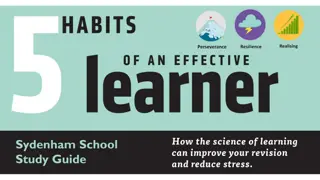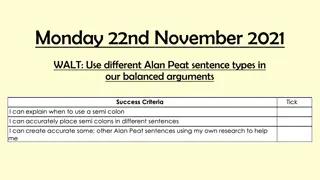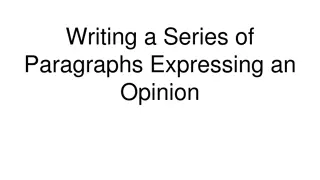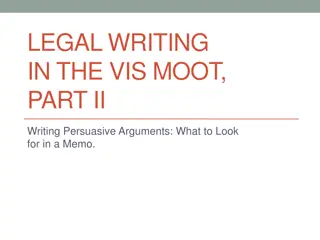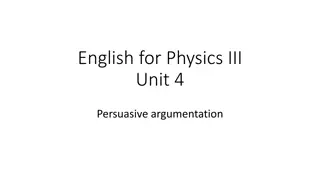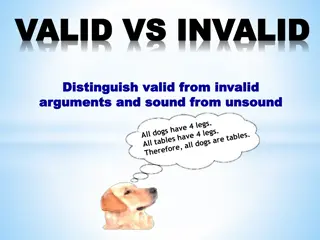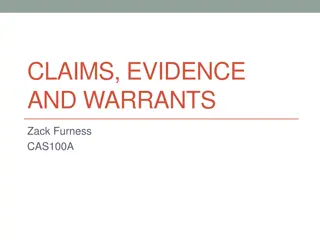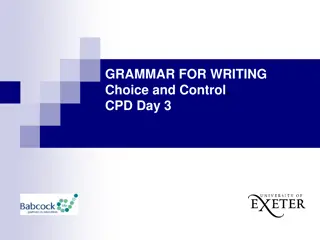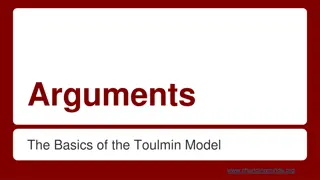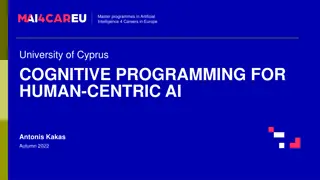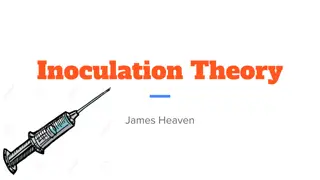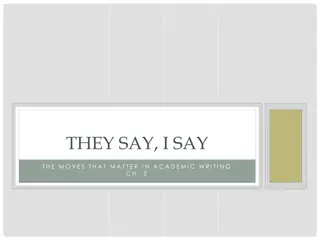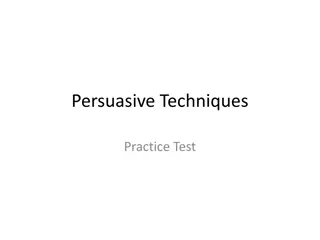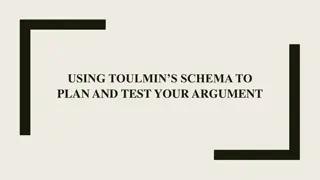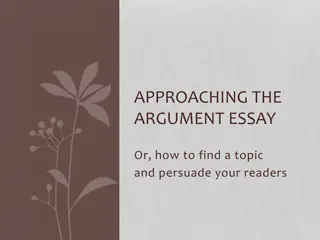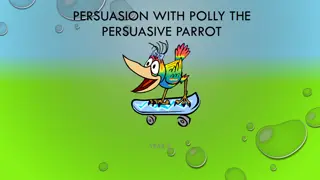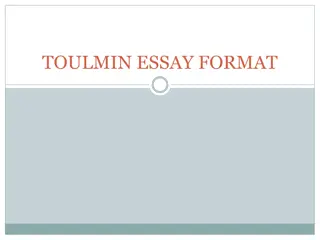Mastering the Toulmin Method for Constructing Persuasive Arguments
Learn how to effectively structure arguments using the Toulmin Method, which consists of Claim, Data, Warrant, Backing, Counterclaim, and Rebuttal elements. Explore reasoning and logic concepts, differentiate between inductive and deductive reasoning, and understand how to construct valid arguments with compelling evidence. Dive into examples showcasing the effectiveness of hybrid cars in combating pollution.
Download Presentation

Please find below an Image/Link to download the presentation.
The content on the website is provided AS IS for your information and personal use only. It may not be sold, licensed, or shared on other websites without obtaining consent from the author.If you encounter any issues during the download, it is possible that the publisher has removed the file from their server.
You are allowed to download the files provided on this website for personal or commercial use, subject to the condition that they are used lawfully. All files are the property of their respective owners.
The content on the website is provided AS IS for your information and personal use only. It may not be sold, licensed, or shared on other websites without obtaining consent from the author.
E N D
Presentation Transcript
Claim and Evidence Workshop Lyn Nazia Davis, Marcos Castillo, and Gamie
How to Construct an Argument Use an organizational structure that arranges the argument in a way that will make sense to the reader. The Toulmin Method of logic is a common and easy to use formula for organizing an argument.
The Basic Toulmin Method Format Claim: The overall thesis the writer will argue for. Data: Evidence gathered to support the claim. Warrant (also referred to as a bridge): Explanation of why or how the data supports the claim, the underlying assumption that connects your data to your claim. Backing (also referred to as the foundation): Additional logic or reasoning that may be necessary to support the warrant. Counterclaim: A claim that negates or disagrees with the thesis/claim. Rebuttal: Evidence that negates or disagrees with the counterclaim.
Reasoning and Logic Reasoning is the action of constructing thoughts into a valid argument. When you construct an argument, that argument will be either valid or invalid. A valid argument is reasoning that is comprehensive on the foundation of logic or fact. Inductive and deductive reasoning are both forms of propositional logic. Propositional logic is the branch of logic that studies ways of joining and/or modifying entire propositions, statements, or sentences to form more complicated propositions, statements, or sentences. This means that propositional logic uses a series of facts and reasoning to develop a conclusion. Inductive and deductive reasoning use propositional logic to develop valid arguments based on fact and reasoning. Both types of reasoning have a premise and a conclusion. How each type of reasoning gets to the conclusion is different.
Claim Hybrid cars are an effective strategy to fight pollution.
Data and Warrant 1 Driving a private car is a citizen's most air-polluting activity. Because cars are the largest source of private, as opposed to industry-produced, air pollution, switching to hybrid cars should have an impact on fighting pollution.
Data and Warrant 2 Each vehicle produced is going to stay on the road for roughly 12 to 15 years. Cars generally have a long lifespan; thus a decision to switch to a hybrid car will make a long-term impact on pollution levels.
Data and Warrant 3 Hybrid cars combine a gasoline engine with a battery- powered electric motor. This combination of technologies means that less pollution is produced. According to ineedtoknow.org, "the hybrid engine of the Prius, made by Toyota, produces 90 percent fewer harmful emissions than a comparable gasoline engine."
Counterclaim Instead of focusing on cars, which still encourages a culture of driving even if it cuts down on pollution, the nation should focus on building and encouraging the use of mass transit systems.
Rebuttal While mass transit is an environmentally sound idea that should be encouraged, it is not feasible in many rural and suburban areas, or for people who must commute to work; thus hybrid cars are a better solution for much of the nation's population.
Organizing a Rebuttal When you rebut or refute an opposing position, use the following three-part organization: The opponent s argument: Usually, you should not assume that your reader has read or remembered the argument you are refuting. Thus at the beginning of your paragraph, you need to state, accurately and fairly, the main points of the argument you will refute.
Organizing a Rebuttal Your position: Next, make clear the nature of your disagreement with the argument or position you are refuting. Your position might assert, for example, that a writer has not proved his assertion because he has provided evidence that is outdated, or that the argument is filled with fallacies.
Organizing a Rebuttal Your refutation: The specifics of your counter argument will depend upon the nature of your disagreement. If you challenge the writer s evidence, then you must present the more recent evidence. If you challenge assumptions, then you must explain why they do not hold up. If your position is that the piece is filled with fallacies, then you must present and explain each fallacy.
Organizing Claim and Evidence: Using Induction Reasoning: Induction is the type of bottom-up reasoning that moves from specific facts to a general conclusion. When you use induction in your paper, you will state your thesis (which is actually the conclusion you have come to after looking at all the facts) and then support your thesis with the facts.
Organizing Claim and Evidence: Using deductive Reasoning Deduction: When you use deduction in an argument, you begin with general premises and move to a specific conclusion. There is a precise pattern you must use when you reason deductively. This pattern is called syllogistic reasoning (the syllogism). Deductive reasnoning is known as a top-down reasoning since it starts with a premise and then uses evidence to support it. Syllogistic reasoning (deduction) is organized in three steps: Major premise Minor premise Conclusion
Using Research and Evidence First-hand research is research you have conducted yourself such as interviews, experiments, surveys, or personal experience and anecdotes. Second-hand research is research you are getting from various texts that has been supplied and compiled by others such as books, periodicals, and Web sites. Regardless of what type of sources you use, the sources must be credible. In other words, your sources must be reliable, accurate, and trustworthy.
Using Research and Evidence Who is the author? Credible sources are written by authors respected in their fields of study. Responsible, credible authors will cite their sources so that you can check the accuracy of and support for what they've written. (This is also a good way to find more sources for your own research.)
Using Research and Evidence How recent is the source? The choice to seek recent sources depends on your topic.
Using Research and Evidence What type of sources does your audience value? If you are writing for a professional or academic audience, they may value peer-reviewed journals as the most credible sources of information.
Using Research and Evidence Be especially careful when evaluating Internet sources! Never use Web sites where an author cannot be determined, unless the site is associated with a reputable institution such as a respected university, a credible media outlet, government program or department, or well- known non-governmental organizations.
Using Rhetorical Appeals in Argumentation Logos or the appeal to reason relies on logic or reason. It refers to the use of facts, dates, statistics, historical references, common-sense reasoning, deductive/logical reasoning, question-answer, comparison-contrast, cause-effect reasoning, or the use of examples to support a previously-mentioned claim. Ethos or the ethical appeal is based on the character, credibility, or reliability of the writer. It refers to how the speaker or writer uses stylistic and/or linguistic choices to establish his/her credibility, authority, believability, or good character. Pathos or emotional appeals appeal to an audience's needs, values, and emotional sensibilities through words, expressions, images, vivid language choices, etc.
In analyzing ethos, you should consider: What do these quotes demonstrate about the speaker's /writer s character? Where and how do the quotes demonstrate how the speaker/writer seems trustworthy, truthful, humble, gracious, honest, honorable, moral, and a decent human being to his audience? How does this ethos affect the speaker s/writer s ability to persuade the audience with his/her claims and win over people s trust?
In analyzing pathos, you should consider: How and where does the quote appeal to our emotions? Are there specific words, expressions, images, vivid language choices, etc, used to create a particular emotional effect on us as the audience? What are we made to feel by the speaker/writer? Are we made to feel a sense of pity, sympathy, guilt, sadness, fear, happiness, hope, love, joy, etc? For what purpose is the speaker/writer using pathos? Is she/he effective in his use of pathos?
In analyzing logos, you should consider: How does each of the quotes, you chose, demonstrate the use of logic in the argument? Does the quote illustrate the use of facts, dates, statistics, historical references, common-sense reasoning, deductive reasoning, question- answer, comparison-contrast, cause-effect reasoning, or the use of examples to support a previously-mentioned claim? How does the use of logical reasoning and well-supported claims help the speaker persuade their audiences? With what is the speaker/writer trying to persuade us? Has she/he been effective?
Central Tenants in Analyzing an Argument Identifying weaknesses in an author s claim(s) Making a concession (if appropriate) Making a refutation that is logical and objective Supporting one s counterargument with relevant source material
How to break down an Argument: Read the article and underline the main points you disagree with or find questionable. Which of these points could you refute? Are they non-factual, fallacious, biased, or unsubstantiated? There should be between 2 and 4 major things you object to; any more would be a list. Give the reasons you disagree with each of the points. What type of reasoning, logic, or evidence can you use to refute these points? Find support for your opposing view from other secondary sources. Identify any way in which the author s use of language colors her argument. Decide which of the author s points should be quoted directly and which should be paraphrased. Create an outline organizing the points you disagree with and your counter arguments. Include at least one concession in your rebuttal.
Sample Reading: Argument Abstract: Children and teens who commit crimes in the United States are usually processed in juvenile courts and sent to special rehabilitation centers, from which they are released at age 18 or 21. But in the last several years there is a public outcry calling this treatment too light, and a trend toward trying violent youth who commit adult crimes in regular criminal courts. Some prosecutors want children as young as 10 years old to be tried in the regular adult courts. Linda J. Collier, a juvenile judge in Arkansas, is one of the advocates for a crack down on juvenile offenders. In her article Adult Crime, Adult Time, written for The Washington Post, she states her case for trying juveniles as adults. Carefully evaluate her claims, her evidence, and her reasoning, noting both strengths and weaknesses in her argumentation. Required Readings: Collier, Linda J. Adult Crime, Adult Time. Washington Post. 6 Apr. 1998. Rpt. in The Contemporary Reader. 7thed. Ed. Gary Goshgarian. New York: Longman, 2002. 219-221. http://www.washingtonpost.com/wp-srv/national/longterm/juvmurders/stories/adultcrime.htm?noredirect=on


